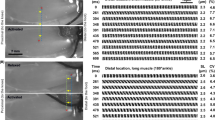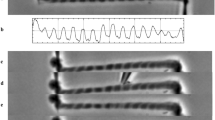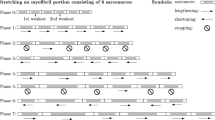Abstract
The aim of the present study is to test whether mechanical strain uniquely regulates muscle fibre atrophy/hypertrophy and adaptation of the number of sarcomeres in series within mature muscle fibres in vitro. Mature single muscle fibres from Xenopus laevis illiofibularis muscle were cultured (4--97 days) while kept at negative strain (∽ 20% below passive slack length, `short fibres') or at positive strain (∽ 5% over passive slack length, “ 8long fibres ” 9). Before and after culture the number of sarcomeres in series was determined using laser diffraction. During culture, twitch and tetanic force characteristics were measured every day.
Survival time of long fibres was substantially less than that of short fibres. Of the long fibres 40% died or became inexcitable within 1 week, whereas this did not occur for short fibres. During culture, twitch and tetanic force of all short fibres increased substantially. Regression analysis showed that the post-culture number of sarcomeres in series was not significantly changed compared to the number before culture. It is concluded that culture at negative strain does not result in atrophy or a reduction of the number of sarcomeres in series, even after 97 days. For the long fibres we did not detect any hypertrophy as tetanic force remained stable or decreased slowly, while twitch force varied. Regression analysis of the change of the number of sarcomeres in series as a function of the culture time showed a positive slope (P = 0.054). Two out of four long fibres that were cultured for at least 2 weeks showed an increase in the number of sarcomeres of 4--5%. Compared with in vivo adaptation to mechanical stimuli this is much less than would be expected. The data suggest that strain may not be the only factor that regulates hypertrophy and the number of sarcomeres in series.
Similar content being viewed by others
References
Adams GR and McCue SA (1998) Localized infusion of IGF-I results in skeletal muscle hypertrophy in rats. J Appl Physiol 84: 1716–1722.
Ahn AN, Monti RJ and Biewener AA (2003) In vivo and in vitro heterogeneity of segment length changes in the semimembranosus muscle of the toad. J Physiol (Lond) 549: 877–888.
Barton-Davis ER, Shoturma DI and Sweeney HL (1999) Contribution of satellite cells to IGF-I induced hypertrophy of skeletal muscle.Acta Physiol Scand 167: 301–305.
Bekoff A and Betz W (1977) Properties of isolated adult rat muscle fibres maintained in tissue culture. J Physiol (Lond) 271: 537–547.
Belcastro AN, Shewchuk LD and Raj DA (1998) Exercise-induced muscle injury: a calpain hypothesis. Mol Cell Biochem 179: 135–145.
Berchtold MW, Brinkmeier H and Muntener M (2000) Calcium ion in skeletal muscle: its crucial role for muscle function, plasticity, and disease. Physiol Rev 80: 1215–1265.
Bland JM and Altman DG (1995) Calculating correlation coefficients with repeated observations: Part 1 –Correlation within subjects. BMJ 310: 446.
Borgers M, Thone F, Verheyen A and Ter Keurs HE (1984) Localization of calcium in skeletal and cardiac muscle. Histochem J 16: 295–309.
Burkholder TJ and Lieber RL (1998) Sarcomere number adaptation after retinaculum transection in adult mice. J Exp Biol 201: 309–316.
Carson JA and Alway SE (1996) Stretch overload-induced satellite cell activation in slow tonic muscle from adult and aged Japanese quail. Am J Physiol 270: C578–C584.
Casaburi R (2000) Skeletal muscle function in COPD. Chest 117: 267S–271S.
Clark A and Coats A (1994) Mechanisms of exercise intolerance in cardiac failure: abnormalities of skeletal muscle and pulmonary function. Curr Opin Cardiol 9: 305–314.
Crawford GN (1973) The growth of striated muscle immobilized in extension. J Anat 114: 165-183.
Euler USV (1935) Some factors influencing the heat production of muscle after stretching. J Physiol (Lond) 84: 1–14.
Feng TP (1932) The effect of length on the resting metabolism of muscle. J Physiol (Lond) 74: 441–454.
Glavinovic MI, Miledi R and Nakajima Y (1983) Morphological and physiological changes in dissociated adult frog muscle fibres after prolonged culturing. Proc R Soc Lond B Biol Sci 219: 91–101.
Goldspink G (1971) Changes in striated muscle fibres during contraction and growth with particular reference to myofibril splitting. J Cell Sci 9: 123–137.
Goldspink G (1999) Changes in muscle mass and phenotype and the expression of autocrine and systemic growth factors by muscle in response to stretch and overload. J Anat 194: 323–334.
Goldspink G, Tabary C, Tabary JC, Tardieu C and Tardieu G (1974) Effect of denervation on the adaptation of sarcomere number and muscle extensibility to the functional length of the muscle. J Physiol (Lond) 236: 733–742.
Goldspink G, Yang SY, Skarli M and Vrbova G (1996) Local growth regulation is associated with an isoform of IGF-1 that is expressed in normal muscle but not in dystrophic muscle when subjected to stretch. J Physiol (Lond) 496p: 10.
Gordon AM, Huxley AF and Julian FJ (1966) The variation in isometric tension with sarcomere length in vertebrate muscle fibres. J Physiol (Lond) 184: 170–192.
Gulve EA and Dice JF (1989) Regulation of protein synthesis and degradation in L8 myotubes. Effects of serum, insulin and insulinlike growth factors. Biochem J 260: 377–387.
Hawke TJ and Garry DJ (2001) Myogenic satellite cells: physiology to molecular biology. J Appl Physiol 91: 534–551.
Hayat A, Tardieu C, Tabary JC and Tabary C (1978) Effects of denervation on the reduction of sarcomere number in cat soleus muscle immobilized in shortened position during seven days. J Physiol (Paris) 74: 563–567.
Heslinga JW and Huijing PA (1993) Muscle length-force characteristics in relation to muscle architecture: a bilateral study of gastrocnemius medialis muscles of unilaterally immobilized rats. Eur J Appl Physiol 66: 289–298.
Heslinga JW, te Kronnie G and Huijing PA (1995) Growth and immobilization effects on sarcomeres: a comparison between gastrocnemius and soleus muscles of the adult rat. Eur J Appl Physiol 70: 49–57.
Huijing PA and Baan GC (2001) Extramuscular myofascial force transmission within the rat anterior tibial compartment: proximodistal differences in muscle force. Acta Physiol Scand 173: 297–311.
Huijing PA and Baan GC (2003) Myofascial force transmission: muscle relative position and length determine agonist and synergist muscle force. J Appl Physiol 94: 1092–1107.
Huijing PA and Woittiez RD (1984) The effect of muscle architecture on skeletal muscle performance: a simple planimetric model. Netherlands J Zool 34: 21–32.
Jaspers RT, Feenstra HM, Huijing PA and van der Laarse WJ (2000) Effects of stretch on mature single muscle fibres of Xenopus laevis in long term culture are not explained by the Feng effect. J Mus Res Cell Motil 21: 799.
Jaspers RT, Feenstra HM, Lee-De Groot LM, Huijing PA and van der Laarse WJ (2001) Twitch and tetanic tension during culture of mature Xenopus laevis single muscle fibres. Arch Physiol Biochem 109: 410–417.
Koh TJ and Herzog W (1998) Excursion is important in regulating sarcomere number in the growing rabbit tibialis anterior. J Physiol (Lond) 508: 267–280.
Lännergren J and Smith RS (1966) Types of muscle fibres in toad skeletal muscle. Acta Physiol Scand 68: 263–274.
Lee-de Groot MB and Van der Laarse WJ (1996) Twitch characteristics and energy metabolites of mature muscle fibres of Xenopus laevis in culture. J Muscle Res Cell Motil 17: 439–448.
Maas H, Baan GC and Huijing PA (2001) Intermuscular interaction via myofascial force transmission: effects of tibialis anterior and extensor hallucis longus length on force transmission from rat extensor digitorum longus muscle. J Biomech 34: 927–940.
McCall GE, Allen DL, Linderman JK, Grindeland RE, Roy RR, Mukku VR and Edgerton VR (1998) Maintenance of myonuclear domain size in rat soleus after overload and growth hormone/IGFI treatment. J Appl Physiol 84: 1407–1412.
McKoy G, Ashley W, Mander J, Yang SY, Williams N, Russell B and Goldspink G (1999) Expression of insulin growth factor-1 splice variants and structural genes in rabbit skeletal muscle induced by stretch and stimulation. J Physiol (Lond) 516: 583–592.
Mitchell PO, Mills ST and Pavlath GK (2002) Calcineurin differentially regulates maintenance and growth of phenotypically distinct muscles. Am J Physiol Cell Physiol 282: C984–C992.
Monier S and Le Marchand-Brustel Y (1982) Insulin affects only initiation and not elongation in protein synthesis in soleus muscles of lean and obese mice. FEBS Lett 147: 211–214.
Morgan DL (1990) New insights into the behavior of muscle during active lengthening. Biophys J 57: 209–221.
Mozdziak PE, Pulvermacher PM, Schultz E and Schell K (2000) Hoechst fluorescence intensity can be used to separate viable bromodeoxyuridine-labeled cells from viable non-bromodeoxyuridine-labeled cells. Cytometry 41: 89–95.
Muscatello U, Margereth A and Aloisi M (1965) On the differential response of sarcoplasm and myoplams to denervation in frog muscle. J Cell Biol 27: 1–24.
Ohira Y, Ohira M, Chen M and Holloszy JO (1989) Organ culture of frog muscle: maintenance of mass, enzyme levels, and contractile force. J Appl Physiol 67: 466–471.
Oishi Y, Imoto K, Ogata T, Taniguchi K, Matsumoto H and Roy RR (2002) Clenbuterol induces expression of multiple myosin heavy chain isoforms in rat soleus fibres. Acta Physiol Scand 176: 311–318.
Page SG and Huxley HE (1963) Filament lengths in striated muscle. J Cell Biol 19: 369–390.
Pappas GP, Asakawa DS, Delp SL, Zajac FE and Drace JE (2002) Nonuniform shortening in the biceps brachii during elbow flexion. J Appl Physiol 92: 2381–2389.
Perrone CE, Fenwick-Smith D and Vandenburgh HH (1995) Collagen and stretch modulate autocrine secretion of insulin-like growth factor-1 and insulin-like growth factor binding proteins from differentiated skeletal muscle cells. J Biol Chem 270: 2099–2106.
Phelan JN and Gonyea WJ (1997) Effect of radiation on satellite cell activity and protein expression in overloaded mammalian skeletal muscle. Anat Rec 247: 179–188.
Rosenblatt JD, Yong D and Parry DJ (1994) Satellite cell activity is required for hypertrophy of overloaded adult rat muscle. Muscle Nerve 17: 608–613.
Sayegh JF and Lajtha A (1989) In vivo rates of protein synthesis in brain, muscle, and liver of five vertebrate species. Neurochem Res 14: 1165–1168.
Shevchenko S, Feng W, Varsanyi M and Shoshan-Barmatz V (1998) Identification, characterization and partial purification of a thiolprotease which cleaves specifically the skeletal muscle ryanodine receptor/Ca2+ release channel. J Membr Biol 161: 33–43.
Shimizu M, Webster C, Morgan DO, Blau HM and Roth RA (1986) Insulin and insulinlike growth factor receptors and responses in cultured human muscle cells. Am J Physiol 251: E611–E615.
Smith RS and Ovalle WK Jr. (1973) Varieties of fast and slow extrafusal muscle fibres in amphibian hind limb muscles. J Anat 116: 1–24.
Snowdowne KW (1986) The effect of stretch on sarcoplasmic free calcium of frog skeletal muscle at rest. Biochim Biophys Acta 862: 441–444.
Spector SA, Simard CP, Fournier M, Sternlicht E and Edgerton VR (1982) Architectural alterations of rat hind-limb skeletal muscles immobilized at different lengths. Exp Neurol 76: 94–110.
Sugden PH and Fuller SJ (1991) Regulation of protein turnover in skeletal and cardiac muscle. Biochem J 273: 21–37.
Swatland HJ (1980) Analysis of growth in a complex muscle (M. supracoracoideus, Anas platyrhynchos). Growth 44: 139–146.
Tabary JC, Tabary C, Tardieu C, Tardieu G and Goldspink G (1972) Physiological and structural changes in the cat's soleus muscle due to immobilization at different lengths by plaster casts. J Physiol (Lond) 224: 231–244.
Tabary JC, Tardieu C, Tardieu G and Tabary C (1981) Experimental rapid sarcomere loss with concomitant hypoextensibility. Muscle Nerve 4: 198–203.
Tardieu C, Tabary JC, Gagnard L, Lombard M, Tabary C and Tardieu G (1974) Change in the number of sarcomeres and in isometric tetanic tension after immobilization of the cat anterior tibialis muscle at different lengths. J Physiol (Paris) 68: 205–218.
Tardieu G, Tabary JC, Tardieu C, Tabary C, Gagnard L and Lombard M (1973) Adjustment of the number of sarcomeres of the muscle fiber to its required length. Consequence of this regulation and of its disorders observed in neurology. Rev Neurol (Paris) 129: 21–42.
van Eijden TM and Raadsheer MC (1992) Heterogeneity of fiber and sarcomere length in the human masseter muscle. Anat Rec 232: 78–84.
Vandenburgh HH, Karlisch P, Shansky J and Feldstein R (1991) Insulin and IGF-I induce pronounced hypertrophy of skeletal myofibers in tissue culture. Am J Physiol 260: C475–C484.
Wang K, Forbes JG and Jin AJ (2001) Single molecule measurements of titin elasticity. Prog Biophys Mol Biol 77: 1–44.
Willems ME and Huijing PA (1994) Heterogeneity of mean sarcomere length in different fibres: effects on length range of active force production in rat muscle. Eur J Appl Physiol Occup Physiol 68: 489–496.
Williams PE and Goldspink G (1971) Longitudinal growth of striated muscle fibres. J Cell Sci 9: 751–767.
Williams PE and Goldspink G (1978) Changes in sarcomere length and physiological properties in immobilized muscle. J Anat 127: 459–468.
Winchester PK, Davis ME, Alway SE and Gonyea WJ (1991) Satellite cell activation in the stretch-enlarged anterior latissimus dorsi muscle of the adult quail. Am J Physiol 260: C206–C212.
Yang S, Alnaqeeb M, Simpson H and Goldspink G (1996) Cloning and characterization of an IGF-1 isoform expressed in skeletal muscle subjected to stretch. J Muscle Res Cell Motil 17: 487–495.
Yang S, Alnaqeeb M, Simpson H and Goldspink G (1997) Changes in muscle fibre type, muscle mass and IGF-I gene expression in rabbit skeletal muscle subjected to stretch. J Anat 190: 613–622.
Yang SY and Goldspink G (2002) Different roles of the IGF-I Ec peptide (MGF) and mature IGF-I in myoblast proliferation and differentiation. FEBS Lett 522: 156–160.
Yokochi K, Yokochi M and Kodama K (1995) Motor function of infants with spastic hemiplegia. Brain Dev 17: 42–48.
Yucesoy CA, Koopman HJFM, Baan GC, Grootenboer HJ and Huijing PA (2003) Effects of inter-and extramuscular myofascial force transmission on adjacent synergistic muscles: assessment by experiments and finite element modeling. Biomech 36: 1797–1811.
Yucesoy CA, Maas H, Koopman HJFM, Grootenboer HJ and Huijing PA (2003) Extramuscular myofascial force transmission: experiments and finite element modelling. Arch Physiol Biochem 111: in press
Zuurbier CJ and Huijing PA (1993) Changes in geometry of actively shortening unipennate rat gastrocnemius muscle. J Morphol 218: 167–180.
Author information
Authors and Affiliations
Rights and permissions
About this article
Cite this article
Jaspers, R.T., Feenstra, H.M., Verheyen, A.K. et al. Effects of strain on contractile force and number of sarcomeres in series of Xenopus laevis single muscle fibres during long-term culture. J Muscle Res Cell Motil 25, 285–296 (2004). https://doi.org/10.1007/s10974-004-8716-8
Issue Date:
DOI: https://doi.org/10.1007/s10974-004-8716-8




